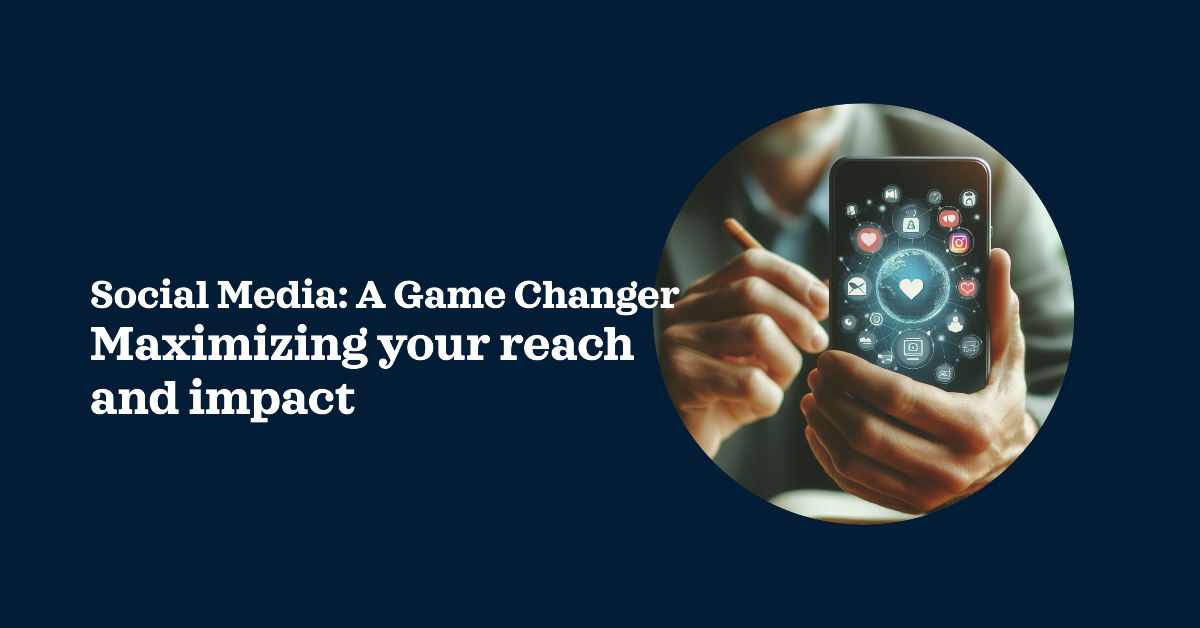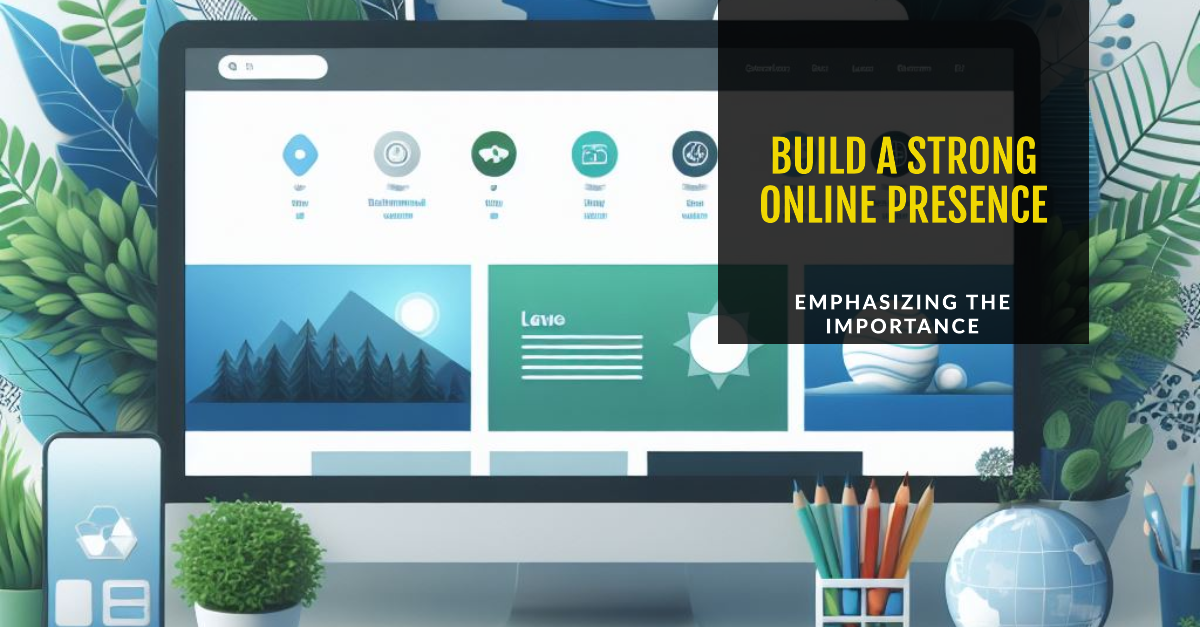In the vast digital marketing arena, relying only on SEO can leave many opportunities untapped. A truly effective online presence requires a comprehensive approach. This revamped article, building a strong online presence, will guide you through a broader strategy for digital prominence.
The Timeless Reign of Content

In the vast and ever-evolving digital marketing landscape, one constant remains: the enduring power of content. Its timeless reign can be attributed to its core function as the primary medium through which brands communicate, educate, and engage their audiences.
The phrase “Content is King” has become somewhat clichéd, but its truth cannot be overstated. This is because, at its heart, marketing is about storytelling. Content allows brands to tell stories, share values, and convey unique selling points. But why does content have such an enduring presence in the digital realm?
1. Evolution of Content Consumption: Building a Strong Online Presence
Over the years, the ways people consume content have changed dramatically. The format and platforms have shifted from print to digital, from desktop to mobile, and from articles to videos. However, the need for content has remained consistent. People always seek information, entertainment, or solutions, and content serves these needs.
2. Establishing Authority:
Good quality content positions brands as authorities in their field. When a company regularly produces insightful, helpful, and authoritative content, it not only boosts its SEO rankings but also earns the trust of its readers. Over time, this trust can translate into brand loyalty and customer conversions.
3. Building Relationships:
Content serves as a bridge between brands and their audiences. Through consistent and valuable content, brands can foster a deeper relationship with their audience, turning casual visitors into engaged community members and loyal customers.
4. Adaptability:
One of the strengths of content lies in its adaptability. It can be tailored to fit different platforms, demographics, and purposes. Whether it’s a blog post, an infographic, a podcast, or a video tutorial, content can be moulded to fit the ever-changing preferences of the audience.
5. Driving Conversions: Building a Strong Online Presence
At its core, content marketing aims to drive actions. With strategically placed calls-to-action, insightful data, and compelling narratives, content can guide readers through the sales funnel, from awareness to conversion.
Key takeaways:
- Keep your content fresh and updated.
- Address the evolving needs and interests of your audience.
- Diversify! Think blog posts, infographics, videos, and even podcasts.
Harnessing the Power of Social Media

In the age of digital connectivity, social media platforms are more than just spaces for personal interaction and entertainment. They have evolved into powerful marketing tools, enabling brands to reach audiences worldwide, foster community engagement, and drive business growth. Harnessing the power of social media can elevate a brand’s online presence, building meaningful relationships with customers and enhancing brand value.
1. Amplifying Brand Visibility
Social media platforms like Facebook, Instagram, Twitter, and LinkedIn serve as vast digital marketplaces with diverse user demographics. By establishing a presence on these platforms, brands can significantly increase their visibility, reaching potential customers across different age groups, interests, and geographical locations. Regular posting, engaging visuals, and strategically using hashtags can further amplify a brand’s reach, making it more discoverable to a broader audience.
2. Engaging with the Audience: Building a Strong Online Presence
At its core, social media is about building communities and fostering conversations. Brands can leverage this by actively engaging with their audience through comments, messages, and discussions. Responding to customer queries, addressing concerns, and appreciating positive feedback builds a positive brand image. Moreover, hosting Q&A sessions, polls, and live videos can create interactive experiences, deepening the connection between the brand and its followers.
3. Influencer Collaborations
In the social media realm, influencers are the trendsetters and opinion leaders. Collaborating with influencers whose values align with the brand can be a strategic move to gain credibility and access their follower base. Influencers add a human touch to brand promotion, making it more relatable and authentic to potential customers.
4. Targeted Advertising: Building a Strong Online Presence
One of the standout features of social media marketing is the ability to run highly targeted advertising campaigns. Brands can use user data and analytics to pinpoint their target audience based on age, interests, location, and online behaviour. This precision in targeting ensures that marketing messages reach the most relevant audience, optimizing ad spend and increasing conversion rates.
5. Content Sharing and Virality
The dynamic nature of social media makes it an ideal platform for sharing diverse content, from images and videos to articles and infographics. Creating shareable content increases the likelihood of virality, with users spreading the brand message within their networks. This organic reach is invaluable, as recommendations from friends and family are often perceived as more trustworthy than direct brand advertisements.
6. Analyzing and Adapting
The success of social media efforts can be measured through various analytics tools provided by the platforms. Tracking engagement rates, follower growth, and conversion metrics helps brands understand what resonates with their audience. This data-driven approach allows for continuous adaptation and refinement of social media strategies, ensuring sustained effectiveness.
Key takeaways:
- Target platforms that resonate with your audience.
- Craft content tailored to each platform’s unique style.
- Engagement is key: reply, share, and initiate meaningful dialogues.
Email Marketing: Your Direct Line

In the digital era, where attention spans are fleeting and messages are plentiful, email marketing emerges as a stalwart. It offers brands a direct, personal, and impactful line of communication with their audience. It is a tool that has stood the test of time, evolving and adapting but always remaining relevant.
1. The Unwavering Significance of Email
Email is universal. Trends or platform algorithms don’t bind it. While social media platforms come and go, and their organic reach often dwindles due to ever-changing algorithms, email remains consistent. A message sent is delivered right into the recipient’s personal space. This direct access makes email marketing a powerful tool in the arsenal of digital marketers.
2. Personalization and Segmentation
One of the strongest suits of email marketing lies in its ability for personalization and segmentation. Unlike a generic advertisement broadcasted to a broad audience, emails can be tailored to cater to individual recipients’ specific interests, behaviours, and preferences. This personal touch enhances the message’s relevance, increasing the likelihood of engagement. Marketers can send targeted campaigns by segmenting email lists, ensuring subscribers receive content that aligns with their interests and stage in the buyer’s journey.
3. Cost-effective and High ROI
From a budget perspective, email marketing is notably cost-effective. Brands can reach a vast audience with minimal tools and content creation investment. And the returns? Stellar! For every dollar spent on email marketing, brands often see a substantial return on investment, making it one of the most profitable marketing channels. This efficiency is further amplified by email marketing targeting already interested individuals – those who have willingly subscribed or shown interest in the brand.
4. Building and Nurturing Relationships
Email marketing isn’t just about sales; it’s about relationship-building. Regular newsletters, updates, and value-driven content allow brands to stay top-of-mind, nurture leads, and foster loyalty. By providing subscribers with valuable insights, exclusive deals, or engaging stories, brands can create a consistent, trusted presence in the lives of their audience. Over time, this trust can cement a brand’s position, turning casual subscribers into loyal advocates.
5. Measurable and Adaptable: Building a Strong Online Presence
Another advantage of email marketing is its measurability. Tools and platforms provide detailed analytics – from open and click-through rates to conversions. These metrics offer invaluable insights, allowing marketers to understand what resonates with their audience and what doesn’t. This data-driven approach ensures that strategies can be continuously refined, making email marketing effective and adaptable.
Key takeaways:
- Develop segmented email lists for tailored messaging.
- Deliver value, whether through insights, offers, or stories.
- Continuously refine your approach for better connections.
Influencer Collaborations: Modern-Day Amplifiers

In today’s digital landscape, the power dynamics of marketing have experienced a seismic shift. Where once big brands dominated the narrative, today, individuals with significant online followings — influencers — wield substantial influence. Collaborations between brands and these influencers have emerged as potent amplifiers, echoing brand messages far and wide through authentic, relatable voices.
1. The Rise of Influencer Marketing: Building a Strong Online Presence
The last decade has witnessed a meteoric rise in influencer marketing. With the proliferation of social media platforms and democratized content creation, anyone with a unique voice, talent, or perspective could amass followers. Regardless of their niche, these influencers established deep connections with their audience based on trust, authenticity, and relatability. Recognizing the power of these connections, brands started collaborating with influencers, moving from traditional advertising’s impersonal approach to a more personalized, trust-based strategy.
2. Authenticity is the Name of the Game
The heart of influencer collaborations lies in authenticity. Audiences are savvy; they can discern between genuine endorsements and forced brand placements. Successful influencer collaborations hinge on choosing partners who genuinely resonate with or benefit from a brand’s offerings. Based on their experience, an influencer’s heartfelt endorsement speaks volumes and can sway their audience’s perceptions and purchasing behaviours.
3. Micro vs. Macro: Size Isn’t Always Everything
While big names with millions of followers are often the go-to for collaborations, micro-influencers have undeniable power (those with 1,000 to 100,000 followers). These individuals often boast a more engaged, niche community. Their recommendations come off as friend-to-friend advice rather than celebrity endorsements, often leading to higher engagement rates and more substantial ROI.
4. Bridging the Gap Between Brands and Audiences
One of the most significant advantages of influencer collaborations is bridging the chasm between brands and their potential customers. Traditional advertisements may often miss the mark, appearing too “sales” or out-of-touch. In contrast, influencers, as individuals who have built their reputation by understanding and catering to their followers, know what resonates. They can craft messages in a language and tone that aligns with their audience, making brand messages more palatable and relatable.
5. Evolving Beyond Product Placements
Influencer collaborations have evolved beyond mere product placements or shoutouts. Today, influencers play a role in co-creating content, participating in brand events, and even assisting in product development. Some influencers have even launched collaborative product lines with brands, leveraging their expertise and followers’ insights to create products that genuinely resonate with the audience.
Key takeaways:
- Align with influencers who resonate with your brand values.
- Strive for genuine partnerships and over-rehearsed promotions.
- Gauge the influencer effect on your brand visibility and traction.
UX: The Unsung Hero of Online Engagement

User Experience (UX) transcends mere aesthetics and is crucial in how users perceive and interact with a brand online. It’s about creating intuitive, responsive, enjoyable interactions that create positive brand associations. A well-optimized UX ensures seamless navigation, fast load times, and compatibility across devices, turning fleeting interactions into lasting impressions. A robust UX design can differentiate between passive visitors and devoted users in the digital world.
Key takeaways:
- Ensure compatibility across devices.
- Aim for lightning-fast load times.
- Streamline user journeys with intuitive design.
Community Building: The Digital Campfire

At the heart of successful digital brands lies a strong sense of community. Creating spaces where users can engage, share, and feel a sense of belonging fosters deep brand loyalty. By initiating and nurturing platforms like forums, groups, or interactive chats, brands can transform casual consumers into passionate advocates. Being actively involved and approachable in these digital gatherings strengthens brand loyalty and sparks organic growth through word-of-mouth advocacy.
Key takeaways:
- Initiate platforms for user interactions, such as forums or groups.
- Reward community members with exclusive perks.
- Stay active and approachable in these spaces.
PPC Advertising: The Immediate Boost

In the digital landscape, with its myriad marketing strategies and channels, Pay-Per-Click (PPC) advertising stands out as an instant accelerator. While other methods might require time to build momentum, PPC delivers immediate visibility and tangible results. Here’s a deep dive into PPC’s dynamism and how it offers brands that much-needed instantaneous boost.
1. The Essence of PPC
At its core, PPC is an Internet marketing model in which advertisers pay a fee each time their ad is clicked. Rather than earning organic traffic, brands can essentially buy site visits. This method contrasts Search Engine Optimization (SEO), which requires time and effort to rank organically. While both have merits, PPC’s charm lies in its immediate results.
2. Targeted Reach: Building a Strong Online Presence
One of the standout benefits of PPC is its ability to target ads specifically. Advertisers can choose when and where their ads will appear based on various factors such as keywords, location, time of day, and even user behaviour. This laser-focused approach ensures that ads reach the intended audience at the right time, maximizing potential conversions.
3. Cost-Effective with High ROI: Building a Strong Online Presence
A common misconception is that PPC is an expensive venture. While there’s no denying that bidding wars can hike costs, PPC campaigns can be highly cost-effective if executed correctly. Brands have complete control over their budgets and can set maximum bids for specific keywords. With a well-optimized campaign, the return on investment (ROI) can be substantial, with brands earning much more than they spend.
4. Quick Entry and Immediate Results
PPC is a godsend for new businesses or those entering a competitive market. It allows for quick entry, bypassing the time-intensive process of organic ranking. Whether you’re a startup or an established business launching a new product, PPC offers a platform to generate buzz and visibility instantly.
5. Analytical and Adaptable: Building a Strong Online Presence
The realm of PPC is rife with analytics. Platforms like Google Ads provide detailed insights into every facet of a campaign – from the number of clicks and impressions to conversion rates. These metrics are invaluable for advertisers, offering real-time feedback on campaign performance. Based on these insights, campaigns can be tweaked and optimized on the go, ensuring adaptability and improvement.
6. Enhancing Brand Visibility
Even if users don’t click on an ad, simply appearing in search results can increase brand awareness. It puts the brand’s name and message before potential customers, establishing a subconscious connection. Over time, this can lead to increased organic interactions and brand recall.
Key takeaways:
- Zero in on keywords that mirror your brand essence.
- Define a budget, monitor, and adapt.
- Perfect your ad content and its landing destination for maximum impact.
Conclusion: Building a Strong Online Presence
In the digital realm, resting on laurels isn’t an option. While SEO is a significant puzzle piece, an encompassing strategy places you ahead. The broader picture of online success combines authentic engagement, strategic collaborations, user-centric experiences, and a sense of community. Embrace this comprehensive approach, and watch your brand thrive. If you want to build a strong online presence, click here to learn everything you need to know about building a solid online presence.
Some links in this article may be affiliate links, meaning they could generate compensation to us without any additional cost to you should you choose to purchase a paid plan. These are products we have personally used and confidently endorse. It’s important to note that this website does not offer financial advice. You can review our affiliate disclosure in our privacy policy for more information.




